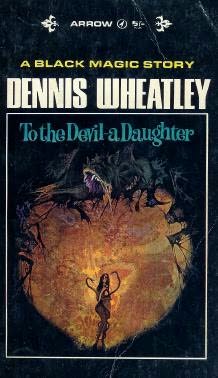
To the Devil…A Daughter (1976) (the movie)
I haven’t read the book of this yet and, after watching the look on Bill’s while we sat through the flick, I don’t know if I want to. I enjoyed the movie for what it was and I almost don’t want to ruin it by knowing just how far they went astray.
The story is vintage Hammer—a hardened occult novelist must save a young, nubile nun from becoming a human vessel for the devil. There is no deep meaning, no stunning subtext. It is the battle between good and evil, Hammer style.
The casting was spot-on, even if the characters themselves are two-dimensional. Richard Widmark is perfect for the role of hardened novelist who seems to have seen it all and can yet be shocked by new sights. Nastassja Kinski works as the young innocent completely oblivious that she is being groomed to help usher evil into the world. The greatest performance, though, comes from Christopher Lee as the evil fallen priest. Nobody can do over-the-top creepy-as-hell the way Lee does. He seems to be savoring every bit of satanic goodness in the story.
Style-wise the film does not disappoint either. While the final confrontation scene is rather dull as far as both writing and pacing, I was not bored at all because of the masterful camerawork by David Watkin. He did some things with a fish eye lens and color tinting I haven’t seen before.

There are certain moments in certain movies that, no matter how awful the rest of the flick is, it automatically becomes cool. Take, for example, Twister. The movie was horrible, yet it was saved by the flying cow that mooed. To the Devil…A Daughter was fun on its own, but did have a coolness factor to it; this movie wins for best use of a demon fetus puppet ever committed to film. I never thought I’d see something that could come near the meat puppets of Lunacy (see this month’s “Worth Googling” column) but, wow, a demon fetus puppet comes close.

Sure, this movie lacks in realistic dialogue, substantial substance or even originality to the plot line. However, this movie didn’t try to have those things. It is what it is, and that was exactly what it was trying to be—an enjoyable horror movie. To complain that it’s missing deepness is like going to Red Lobster and complaining about your steak. I would recommend To the Devil…A Daughter, but only if you are in the mood for a fun fright fest.
--Jen

TO THE DEVIL… A DAUGHTER by Dennis Wheatley
I knew before I watched the movie that Wheatley disliked this movie. I guessed at the reason: the book was part supernatural thriller and part political discourse. The writing is solid and draws the reader into the story, but at many points during the tale Wheatley’s characters engage in short (typically about three paragraphs) discussions about the effects of taxation or Socialism on post-war England and France. It’s somewhat jarring, in part because it seems ham-fisted and in part because I’m unused to seeing such discussions repeatedly engaged in the course of a horror novel.
I think this is a flaw more in my reading than the book. Wheatley is addressing the upper middle class in these countries at a time period just after WWII; it is quite reasonable to assume such discussions were common, especially considering the turmoil which the countries were experiencing. More, if I’m unused to reading it in a novel, it’s primarily because most modern supernatural or horror novels attempt to distance themselves from points of contemporaneous discussion, for fear of dating themselves. Upon analysis, I think the pieces work well in the book, allowing it to skirt the line between the pulp stories of the time and literature.
The story itself is a thriller, with many characters placed into peril and a couple of love stories developing along the way. The main character (a rare strong female lead) and her son first encounter, then attempt to save, a young woman from her curse and her fate. Her curse is that she is possessed by the devil every evening when the sun goes down; her fate is unknown at first, but is expected to be dire. As the story develops, that expectation is met.
There are few of the scenes from the Hammer movie here, and even few points of commonality. The basic story is different; the girl in peril is different; the main character is turned from an Agatha Christie analog into a flighty, sexed-up agent to the new protagonist, an amalgam of her character and the government agent from the book. Hammer took an interesting, although sometimes somewhat forced, novel and turned it into a completely different movie.
I’d have been disappointed too.
Four stars out of five.
